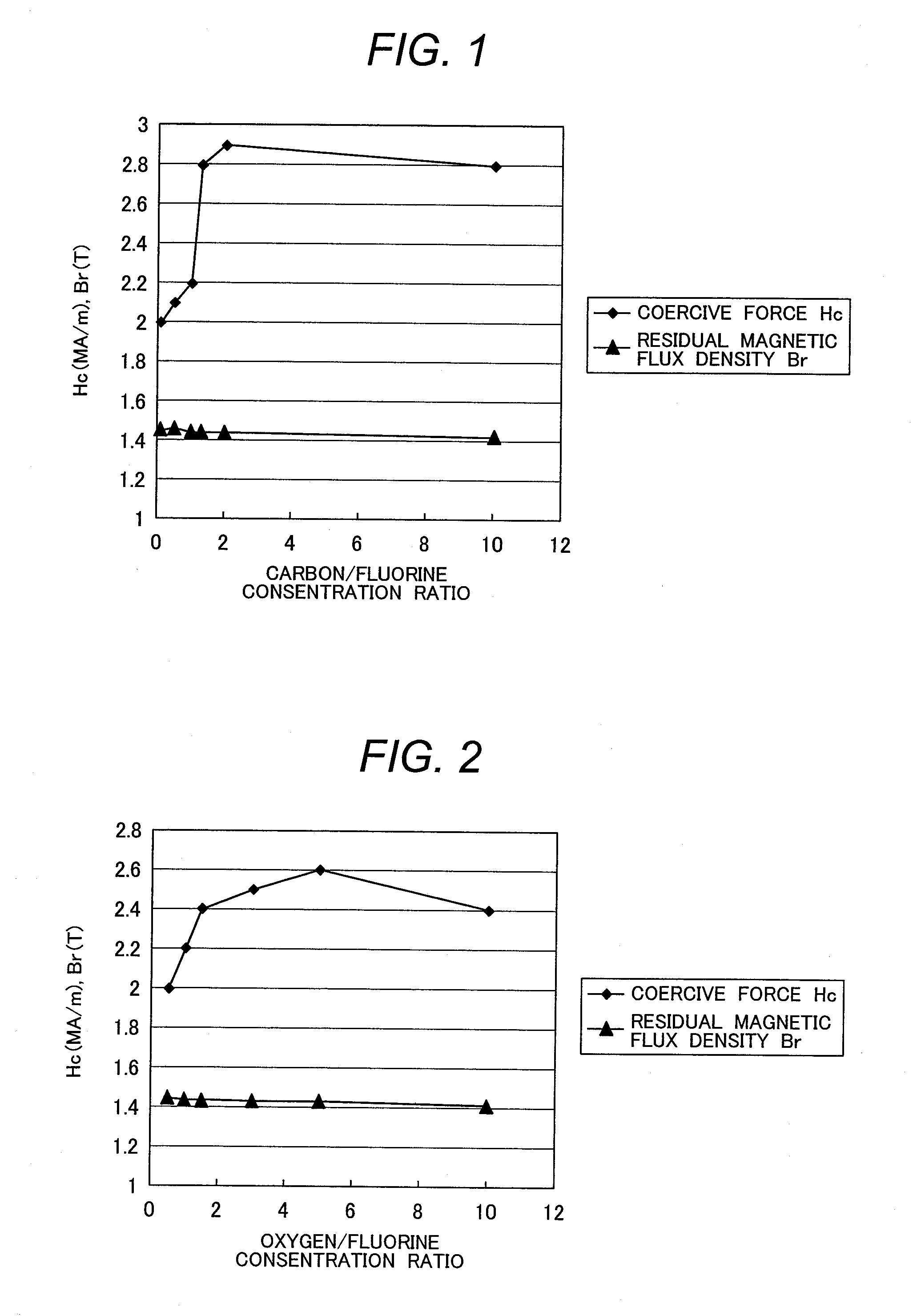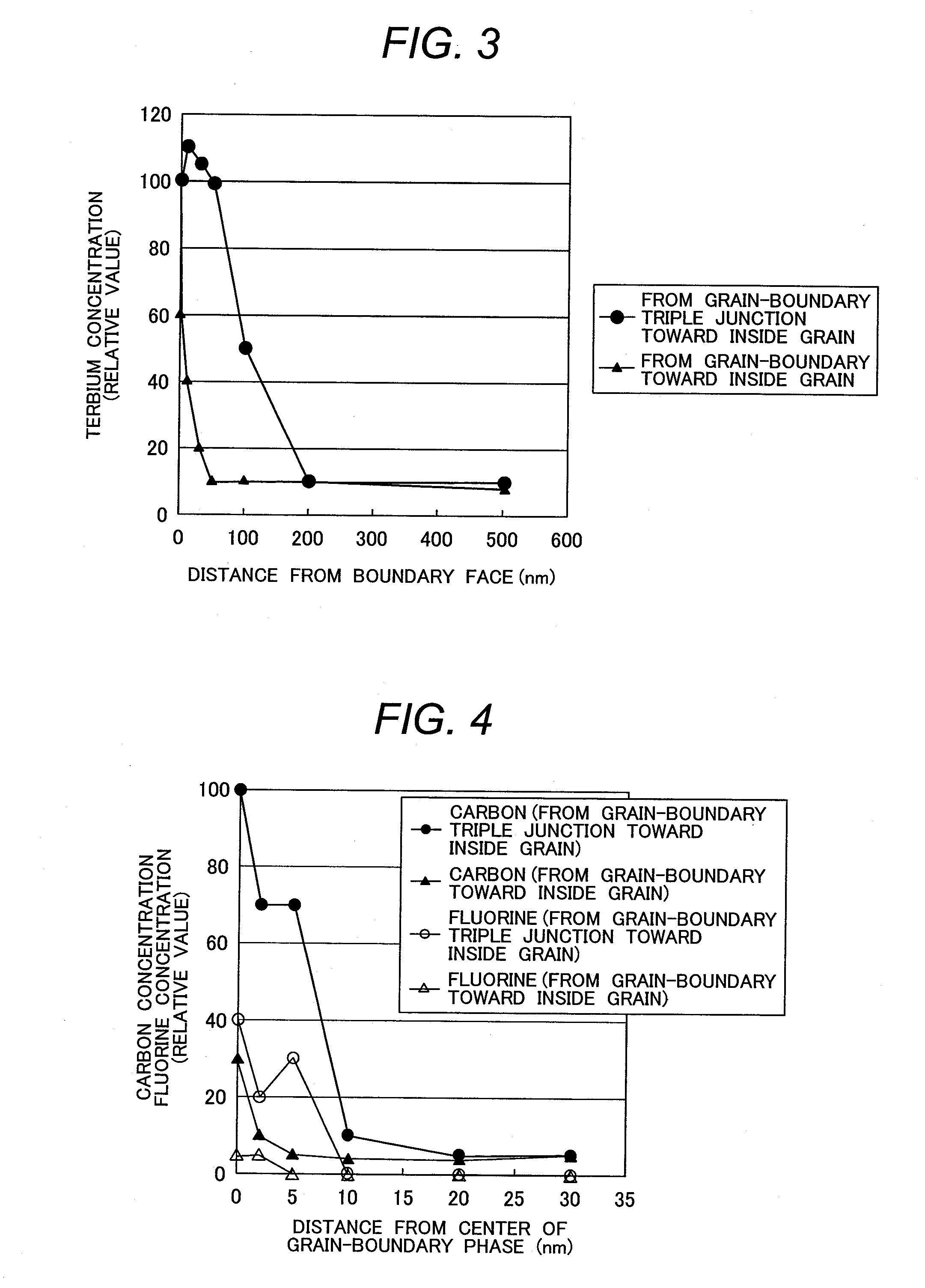Sintered magnet and rotating electric machine using same
a technology of electric machine and sintered magnet, which is applied in the manufacture of magnetic bodies, magnetic materials, inductance/transformers/magnets, etc., can solve the problems of insufficient fluoride coating treatment, the inability to uniformly form a reaction phase along the surface of the magnet powder, and the inability to achieve solution treatment by fluoride coating, etc., to achieve the effect of increasing the thermostability of the magnet, reducing the heat treatment temperature, and increasing the thickness of the sintered magn
- Summary
- Abstract
- Description
- Claims
- Application Information
AI Technical Summary
Benefits of technology
Problems solved by technology
Method used
Image
Examples
example 1
[0054]As an Nd—Fe—B system powder, a magnetic powder having an Nd2Fe14B structure as a main phase is prepared, and a fluoride is formed on a surface of the magnetic powder. For example, when forming DyF3 on the surface of the magnetic powder, raw material of Dy(CH3COO)3 (dysprosium acetate) is dissolved by H2O (pure water), and HF (hydrofluoric acid) is added. The addition of HF creates gelatinous DyF3.xH2O or DyF3.x(CH3COO) (x is a positive number). After this is separated by centrifugation to remove the solvent (after solid-liquid separation), an almost equivalent amount of methanol is added to remove anions, thereby obtaining a light-permeable treatment solution. Viscosity of the treatment solution is almost equal to the viscosity of water.
[0055]The magnetic powder is put into a die and formed into a tentative compact by applying a load of 1 t / cm2 (98 MPa) in a magnetic field of 10 kOe. The tentative compact has a continuous gap (so-called, open pore). Next, a bottom face of the ...
example 2
[0060]As an Nd—Fe—B system powder, a magnetic powder of an average grain size of 5 μm having a main phase of an Nd2Fe14B structure and an approximately 1%-boride and rare earth rich phase is prepared, and a fluoride is formed on a surface of the magnetic powder. For example, when forming DyF3 on the surface of the magnetic powder, raw material of Dy(CH3COO)3 is dissolved by H2O, and HF is added. The addition of HF will form gelatinous DyF3-xH2O or DyF3-x(CH3COO) (x is a positive number). After this is separated by centrifugation to remove the solvent (after solid-liquid separation), an almost equivalent amount of methanol is added to remove anions, thereby obtaining a light-permeable treatment solution. Viscosity of the treatment solution is almost equal to the viscosity of water.
[0061]The magnetic powder is put into a die and formed into a tentative compact by applying a load of 0.5 t / cm2 in a magnetic field of 5 kOe. Relative density of the tentative compact is approximately 60%, ...
example 3
[0067]A Dy—F system treatment solution was prepared as described below. After dysprosium acetate was dissolved in the water, diluted hydrofluoric acid was gradually added to it. An oxyfluoride and an acid fluorine carbide were blended into the solution where a gel-like fluoride was deposited. The mixed solution was agitated by an ultrasonic agitator, solid and liquid were separated by a centrifuge, and methanol was added to the separated solid phase, thereby obtaining a colloidal methanol solution. After the colloidal methanol solution was fully agitated, anions were removed, thereby making the solution transparent. Herein, anions were removed until the transmission factor of the treatment solution in the visible light became 5% or more.
[0068]A tentative compact was prepared as described below. A load of 5 t / cm2 was applied to an Nd2Fe14B magnetic powder in a magnetic field of 10 kOe, thereby forming a tentative compact having a thickness of 20 mm and relative density of 70%. Since ...
PUM
| Property | Measurement | Unit |
|---|---|---|
| Width | aaaaa | aaaaa |
| Width | aaaaa | aaaaa |
| Width | aaaaa | aaaaa |
Abstract
Description
Claims
Application Information
 Login to View More
Login to View More - R&D
- Intellectual Property
- Life Sciences
- Materials
- Tech Scout
- Unparalleled Data Quality
- Higher Quality Content
- 60% Fewer Hallucinations
Browse by: Latest US Patents, China's latest patents, Technical Efficacy Thesaurus, Application Domain, Technology Topic, Popular Technical Reports.
© 2025 PatSnap. All rights reserved.Legal|Privacy policy|Modern Slavery Act Transparency Statement|Sitemap|About US| Contact US: help@patsnap.com



